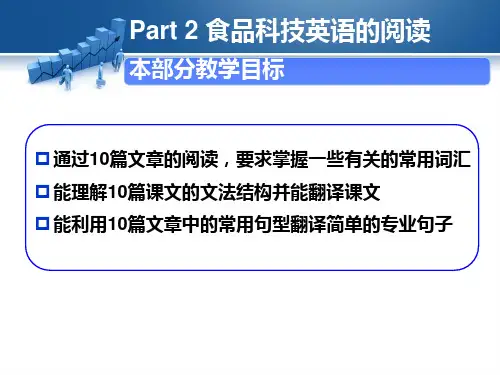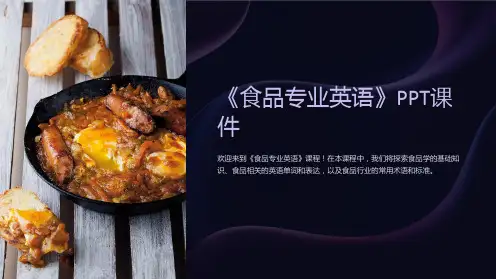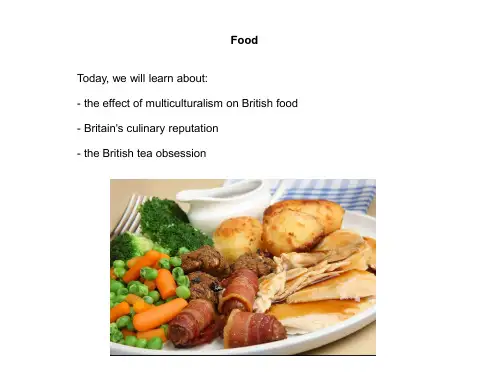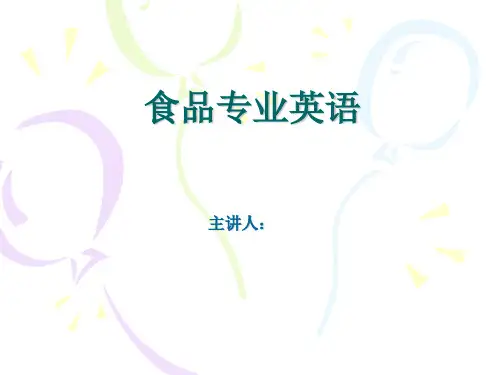食品专业英语课件lesson 12
- 格式:pdf
- 大小:115.96 KB
- 文档页数:5



Food safety 食品安全New wordscarcin(o)- 癌-gen/-genic/-genous 原,产生carinogen 致癌物质toxic 有毒,中毒logical 逻辑学的toxicological 毒物学的anti- 反,抗,非oxidant 氧化剂antioxidant 抗氧化剂radio- 无线电,辐射,放射nuclide 核素radionuclide 放射性核素intra- 内的,在内的intrastate 州内的fraud 欺骗,欺诈safrole 黄樟油精,黄樟素symphytine 聚合草素preservative 防腐剂cadmium 镉mercury 汞The question,“Is the food safe?”, usually evokes an emotional response. Everybody has a right to a safe and wholesome food supply. 食品是否安全这个问题常常会引起人情绪化的反应。
每一个人都有权获得安全、健康的食品。
Yet the question of food safety is a complicated one. 然而食品安全问题是一个复杂的问题。
The concept of food safety has many facets. Perhaps the most obvious, and certainly the most prevalent problem of food safety is microbiological food poisoning. 食品安全有许多方面,也许食品安全中最明显的,最普遍的问题是食品的微生物毒害。
This is serious problem in nearly every country, but another aspect of food safety is primarily concerned with chemicals. 这是几乎在每一个国家都很严重的问题,但是食品安全的另一个主要关注的方面主要与化学药品有关。




电子出版物数据中心中国轻工业出版社出品京新出音[2010]419号ISBN 978-7-89991-109-9高等学校专业教材食品专业英语文选(第二版)许学勤主编目录•Lesson 1 Food Industry •Lesson 2 Water•Lesson 3 Carbohydrates •Lesson 4 Proteins•Lesson 5 Lipids•Lesson 6 Vitamins and Minerals •Lesson 7 Food Additive •Lesson 8 Food Microbiology •Lesson 9 Fermentation Glossary Glossary Glossary Glossary Glossary Glossary Glossary Glossary Glossary•Lesson 10 Physical Properties of Foods•Lesson 11 Food Dispersions•Lesson 12 Food Preservation•Lesson 13 Food Processing•Lesson 14 Unit Operations in Food Processing •Lesson 15 Food Packaging•Lesson 16 Thermal Treatment and Thermal Processing •Lesson 17 Food Concentration•Lesson 18 Food Dehydration and Drying Glossary Glossary Glossary Glossary Glossary Glossary Glossary Glossary Glossary•Lesson 19 Food Freezing•Lesson 20 Extrusion Cooking•Lesson 21 Membrane Separation•Lesson 22 Meat and Meat Products•Lesson 23 Milk and Milk Products•Lesson 24 Poultry and Eggs•Lesson 25 Principles of Baking•Lesson 26 Confectionery and Chocolate Products •Lesson 27 Fruit Juices Glossary Glossary Glossary Glossary Glossary Glossary Glossary Glossary Glossary•Lesson 28 Beverages•Lesson 29 Food Safety•Lesson 30 Hazard Analysis and Critical Control Points •Lesson 31 Good Manufacturing Practice (GMP)•Lesson 32 Sanitation in Food Plant•Lesson 33 Food Quality•Lesson 34 Shelf-life of Food Products Glossary Glossary Glossary Glossary Glossary Glossary Glossary。

电子出版物数据中心中国轻工业出版社出品京新出音[2010]419号ISBN 978-7-89991-109-9高等学校专业教材食品专业英语文选(第二版)许学勤主编目录•Lesson 1 Food Industry •Lesson 2 Water•Lesson 3 Carbohydrates •Lesson 4 Proteins•Lesson 5 Lipids•Lesson 6 Vitamins and Minerals •Lesson 7 Food Additive •Lesson 8 Food Microbiology •Lesson 9 Fermentation Glossary Glossary Glossary Glossary Glossary Glossary Glossary Glossary Glossary•Lesson 10 Physical Properties of Foods•Lesson 11 Food Dispersions•Lesson 12 Food Preservation•Lesson 13 Food Processing•Lesson 14 Unit Operations in Food Processing •Lesson 15 Food Packaging•Lesson 16 Thermal Treatment and Thermal Processing •Lesson 17 Food Concentration•Lesson 18 Food Dehydration and Drying Glossary Glossary Glossary Glossary Glossary Glossary Glossary Glossary Glossary•Lesson 19 Food Freezing•Lesson 20 Extrusion Cooking•Lesson 21 Membrane Separation•Lesson 22 Meat and Meat Products•Lesson 23 Milk and Milk Products•Lesson 24 Poultry and Eggs•Lesson 25 Principles of Baking•Lesson 26 Confectionery and Chocolate Products •Lesson 27 Fruit Juices Glossary Glossary Glossary Glossary Glossary Glossary Glossary Glossary Glossary•Lesson 28 Beverages•Lesson 29 Food Safety•Lesson 30 Hazard Analysis and Critical Control Points •Lesson 31 Good Manufacturing Practice (GMP)•Lesson 32 Sanitation in Food Plant•Lesson 33 Food Quality•Lesson 34 Shelf-life of Food Products Glossary Glossary Glossary Glossary Glossary Glossary Glossary。


Food safety 食品安全New wordscarcin(o)- 癌-gen/-genic/-genous 原,产生carinogen 致癌物质toxic 有毒,中毒logical 逻辑学的toxicological 毒物学的anti- 反,抗,非oxidant 氧化剂antioxidant 抗氧化剂radio- 无线电,辐射,放射nuclide 核素radionuclide 放射性核素intra- 内的,在内的intrastate 州内的fraud 欺骗,欺诈safrole 黄樟油精,黄樟素symphytine 聚合草素preservative 防腐剂cadmium 镉mercury 汞The question,“Is the food safe?”, usually evokes an emotional response. Everybody has a right to a safe and wholesome food supply. 食品是否安全这个问题常常会引起人情绪化的反应。
每一个人都有权获得安全、健康的食品。
Yet the question of food safety is a complicated one. 然而食品安全问题是一个复杂的问题。
The concept of food safety has many facets. Perhaps the most obvious, and certainly the most prevalent problem of food safety is microbiological food poisoning. 食品安全有许多方面,也许食品安全中最明显的,最普遍的问题是食品的微生物毒害。
This is serious problem in nearly every country, but another aspect of food safety is primarily concerned with chemicals. 这是几乎在每一个国家都很严重的问题,但是食品安全的另一个主要关注的方面主要与化学药品有关。
Lesson 12 Food Safety一、Six food safety issues1.The label of foods are not normative. 包装类食品标签不规范2、Food additives do not meet the standard requirements. 食品添加剂不符合标准规定3、Some of the ingredients in foods do not meet requirements . 一些食品的成分含量不符合要求4、Water injection meat still exists. 注水肉现象依然存在5、Aquatic products fairly serious heavy metal over-standard.水产品重金属超标问题比较严重。
6、Some food health indicators failure. 一些食品的卫生不符合要求。
二、texttox- or toxi-or toxo- poison 毒素toxin : 毒素toxenzyme 毒酶toxoid 变性毒素toxic- or toxico- 毒物toxicology 毒理学toxicant 毒药,有毒的carcin- or carcino- : tumor; 癌的carcinogen 致癌物质carcinoid 良性肿瘤have a [no] right to (sth.) 有[没有]要求(某事物)的权利。
subject oneself to 蒙,受。
safrole n. [化学] 黄樟素flavoring agent增香剂,香味料。
flavoring n. 调味品,佐料。
cereal grains 粮谷,谷粒etc. et cetera, and others especially of the same kind.In terms of 在……方面lettuce n. 莴苣lead 铅EpidemiologyFoodborne diseases each year in USAffects 1 in 4 Americans76 million illnesses325,000 hospitalizations5,000 deaths1,500 of those deaths caused by Salmonella, Listeria, and Toxoplasma三、Biological Hazards in FoodBiological = Living Organisms•In Meat and Poultry:•Salmonella bacteria (poultry and eggs)•Trichinella spiralis parasite (pork)•On Fruits and Vegetables:• E. coli bacteria (apple juice)•Cyclospora parasite (raspberries)•Hepatitis A virus (strawberries)How can you prevent Biological Hazard to FoodsPrevention of microbes growingHolding at low temperaturesCooling quicklyCooking helps to kill microbes>165oF(73o C) for poultry and eggs>155oF (68o C) for ground beef>160oF (71o C) for porkCampylobacteriosisSources•Raw or undercooked poultry•Non-chlorinated water•Raw milk•Infected animal or human feces•Poultry, cattle, puppies, kittens, pet birds Clinical signs•Diarrhea, abdominal cramps,fever, nausea•Duration: 2-5 daysSalmonellosis•Gram negative bacteria•Many serotypes can cause disease•S.enteritidis and typhimurium•41% of all human cases•Most common species in U.S.• 1.4 million cases annually•580 deathsSalmonellosis•Sources•Raw poultry and eggs•Raw milk•Raw beef•Unwashed fruit, alfalfa sprouts•Reptile pets: Snakes, turtles, lizards•Signs•Onset: 12-72 hours•Diarrhea, fever, cramps•Duration: 4-7 daysE. coli O157:H7•Enterohemorrhagic Escherichia coli (EHEC) •Surface proteins; toxin•Sources•Undercooked or raw hamburger; salami•Alfalfa sprouts; lettuce•Unpasteurized milk, apple juice or cider•Well water•Animals: Cattle, other mammals•Signs•Watery or bloody diarrhea, nausea, cramps•Onset: 2-5 days•Duration: 5-10 days•Sequela•Hemolytic Uremic Syndrome (HUS)•Acute kidney failure in children•Life threateningOrganisms•Norwalk-like viruses•Campylobacter•Salmonella• E. coli O157:H7•Clostridium botulinum•Shigella spp•Toxoplasma•Emerging organismsNorwalk-like Viruses•Norovirus; Caliciviridae family•Most common foodborne agent•23 million cases annually•Sources•Person-to-person•Shed in human feces, vomitus•Outbreaks in daycares, nursing homes, cruise ships•Contaminated shellfish四、Chemical Hazards in FoodChemical hazard: a toxic substance that is produced naturally added intentionally or un-intentionally•Naturally-occurring:•Natural toxins (aflatoxins, marine toxins)•Added intentionally:•Antibiotics, preservatives•Added non-intentionally:•Cleaning agents, Pesticide Residues五、Physical Hazards in FoodPhysical hazard: a hard foreign object that can cause illness or injury•Inherent to the food or ingredient•Bone fragment, feathers•Contaminant during processing•Stones, rocks, dirt, fingernails六、Prevention and Control1. HACCP•Hazard Analysis Critical Control Point•To monitor and control production processes•Identify food safety hazards and critical control points•Production, processing and marketing•Establish limits•Monitor•Applied to meat, poultry, and eggs2.On Farm Strategies•Testing and removal for Salmonella•Serologic, fecal culture, hide culture •Vaccinating•Many serotypes•Varying effectiveness•Minimize rodents, wild birds•Isolation of new animals3.At the Slaughter Plant•FSIS target organisms•Salmonella and E. coli•Control points•Removal of internal organs•Minimize contact between carcasses•Proper movement through facilities•Chilling•Cooking processes (time, temperature)4. Irradiation•Used since 1986 for Trichina control in pork•Gamma rays•Poultry in 1990/1992•Meat in 1997/1999•Reduction of bacterial pathogens•Kills living cells of organisms•Damaged and cannot survive•Identified with radura…..•Does not affect taste quality•Nutrients remain the same•Handle foods appropriately afterwards•Does not sterilize•Contamination can still occur5.At Home•Drink pasteurized milk and juices•Wash hands carefully and frequently•After using the bathroom•Changing infant’s diapers•Cleaning up animal feces•Wash hands before preparing food•Wash raw fruits and vegetables before eating •After contact with raw meat or poultry•Wash hands, utensils and kitchen surfaces•Hot soapy water•Defrost meats in the refrigerator•Cook beef/beef products thoroughly •Internal temperature of 160oF•Cook poultry and eggs thoroughly •Internal temperature of 170-180oF•Eat cooked food promptly•Refrigerate leftovers within 2 hours after cooking •Store in shallow containers。